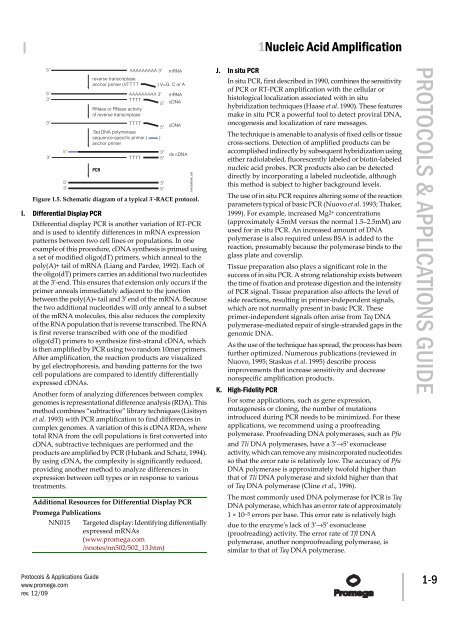Protocols and Applications Guide (US Letter Size) - Promega
Protocols and Applications Guide (US Letter Size) - Promega
Protocols and Applications Guide (US Letter Size) - Promega
You also want an ePaper? Increase the reach of your titles
YUMPU automatically turns print PDFs into web optimized ePapers that Google loves.
| 1Nucleic Acid Amplification<br />
5′<br />
5′<br />
3′<br />
3′<br />
3′<br />
5′<br />
AAAAAAAAA 3′ mRNA<br />
reverse transcriptase<br />
anchor primer (VTTTT ) V=G, C or A<br />
AAAAAAAAA 3′ mRNA<br />
TTTT<br />
RNase or RNase activity<br />
of reverse transcriptase<br />
5′ cDNA<br />
TTTT<br />
5′<br />
Taq DNA polymerase<br />
sequence-specific primer ( )<br />
anchor primer<br />
PCR<br />
TTTT<br />
3′<br />
5′<br />
5′ 3′<br />
3′ 5′<br />
cDNA<br />
ds cDNA<br />
Figure 1.5. Schematic diagram of a typical 3′-RACE protocol.<br />
I. Differential Display PCR<br />
Differential display PCR is another variation of RT-PCR<br />
<strong>and</strong> is used to identify differences in mRNA expression<br />
patterns between two cell lines or populations. In one<br />
example of this procedure, cDNA synthesis is primed using<br />
a set of modified oligo(dT) primers, which anneal to the<br />
poly(A)+ tail of mRNA (Liang <strong>and</strong> Pardee, 1992). Each of<br />
the oligo(dT) primers carries an additional two nucleotides<br />
at the 3′-end. This ensures that extension only occurs if the<br />
primer anneals immediately adjacent to the junction<br />
between the poly(A)+ tail <strong>and</strong> 3′ end of the mRNA. Because<br />
the two additional nucleotides will only anneal to a subset<br />
of the mRNA molecules, this also reduces the complexity<br />
of the RNA population that is reverse transcribed. The RNA<br />
is first reverse transcribed with one of the modified<br />
oligo(dT) primers to synthesize first-str<strong>and</strong> cDNA, which<br />
is then amplified by PCR using two r<strong>and</strong>om 10mer primers.<br />
After amplification, the reaction products are visualized<br />
by gel electrophoresis, <strong>and</strong> b<strong>and</strong>ing patterns for the two<br />
cell populations are compared to identify differentially<br />
expressed cDNAs.<br />
Another form of analyzing differences between complex<br />
genomes is representational difference analysis (RDA). This<br />
method combines “subtractive” library techniques (Lisitsyn<br />
et al. 1993) with PCR amplification to find differences in<br />
complex genomes. A variation of this is cDNA RDA, where<br />
total RNA from the cell populations is first converted into<br />
cDNA, subtractive techniques are performed <strong>and</strong> the<br />
products are amplified by PCR (Hubank <strong>and</strong> Schatz, 1994).<br />
By using cDNA, the complexity is significantly reduced,<br />
providing another method to analyze differences in<br />
expression between cell types or in response to various<br />
treatments.<br />
Additional Resources for Differential Display PCR<br />
<strong>Promega</strong> Publications<br />
NN015 Targeted display: Identifying differentially<br />
expressed mRNAs<br />
(www.promega.com<br />
/nnotes/nn502/502_13.htm)<br />
<strong>Protocols</strong> & <strong>Applications</strong> <strong>Guide</strong><br />
www.promega.com<br />
rev. 12/09<br />
1441MA04_6A<br />
J. In situ PCR<br />
In situ PCR, first described in 1990, combines the sensitivity<br />
of PCR or RT-PCR amplification with the cellular or<br />
histological localization associated with in situ<br />
hybridization techniques (Haase et al. 1990). These features<br />
make in situ PCR a powerful tool to detect proviral DNA,<br />
oncogenesis <strong>and</strong> localization of rare messages.<br />
The technique is amenable to analysis of fixed cells or tissue<br />
cross-sections. Detection of amplified products can be<br />
accomplished indirectly by subsequent hybridization using<br />
either radiolabeled, fluorescently labeled or biotin-labeled<br />
nucleic acid probes. PCR products also can be detected<br />
directly by incorporating a labeled nucleotide, although<br />
this method is subject to higher background levels.<br />
The use of in situ PCR requires altering some of the reaction<br />
parameters typical of basic PCR (Nuovo et al. 1993; Thaker,<br />
1999). For example, increased Mg2+ concentrations<br />
(approximately 4.5mM versus the normal 1.5–2.5mM) are<br />
used for in situ PCR. An increased amount of DNA<br />
polymerase is also required unless BSA is added to the<br />
reaction, presumably because the polymerase binds to the<br />
glass plate <strong>and</strong> coverslip.<br />
Tissue preparation also plays a significant role in the<br />
success of in situ PCR. A strong relationship exists between<br />
the time of fixation <strong>and</strong> protease digestion <strong>and</strong> the intensity<br />
of PCR signal. Tissue preparation also affects the level of<br />
side reactions, resulting in primer-independent signals,<br />
which are not normally present in basic PCR. These<br />
primer-independent signals often arise from Taq DNA<br />
polymerase-mediated repair of single-str<strong>and</strong>ed gaps in the<br />
genomic DNA.<br />
As the use of the technique has spread, the process has been<br />
further optimized. Numerous publications (reviewed in<br />
Nuovo, 1995; Staskus et al. 1995) describe process<br />
improvements that increase sensitivity <strong>and</strong> decrease<br />
nonspecific amplification products.<br />
K. High-Fidelity PCR<br />
For some applications, such as gene expression,<br />
mutagenesis or cloning, the number of mutations<br />
introduced during PCR needs to be minimized. For these<br />
applications, we recommend using a proofreading<br />
polymerase. Proofreading DNA polymerases, such as Pfu<br />
<strong>and</strong> Tli DNA polymerases, have a 3′→5′ exonuclease<br />
activity, which can remove any misincorporated nucleotides<br />
so that the error rate is relatively low. The accuracy of Pfu<br />
DNA polymerase is approximately twofold higher than<br />
that of Tli DNA polymerase <strong>and</strong> sixfold higher than that<br />
of Taq DNA polymerase (Cline et al., 1996).<br />
The most commonly used DNA polymerase for PCR is Taq<br />
DNA polymerase, which has an error rate of approximately<br />
1 × 10–5 errors per base. This error rate is relatively high<br />
due to the enzyme's lack of 3′→5′ exonuclease<br />
(proofreading) activity. The error rate of Tfl DNA<br />
polymerase, another nonproofreading polymerase, is<br />
similar to that of Taq DNA polymerase.<br />
PROTOCOLS & APPLICATIONS GUIDE 1-9
















